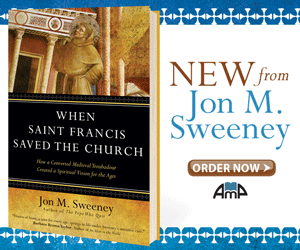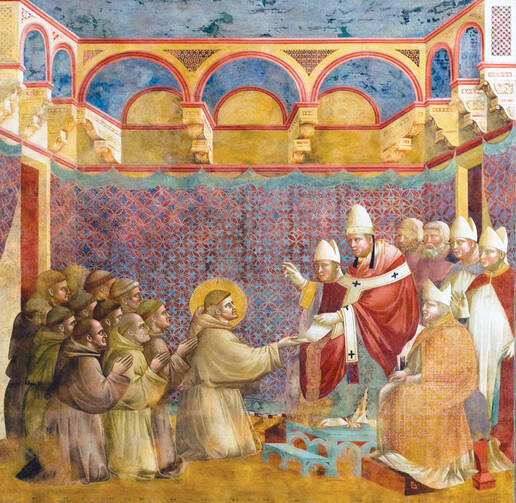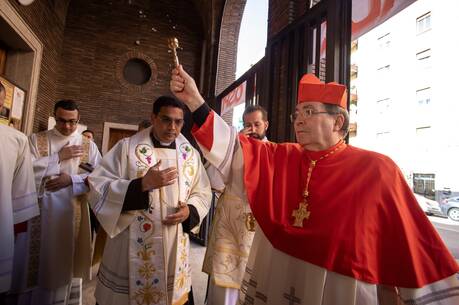Eight hundred years ago a man from Assisi, Italy, was saving the church from its corruption, clericalism, irrelevance and insincerity by waking people up to a renewed focus on the Gospel. His name was Francesco di Bernardone, but we know him as St. Francis of Assisi. Today, Francis is the world’s most popular saint and an inspiration to our pope. But he also is misunderstood.
To meet the real Francis, we have to wipe clean the slate of our cultural and religious imagination and forget some half-formed legends. G. K. Chesterton once wrote, “Truth...must of necessity be stranger than fiction, for we have made fiction to suit ourselves.” Case in point: The unreal Francis is one of the most famous fictional characters in history, too often a mix of saccharine pictures and stories—a figure who sits amid birds or speaks to wolves—that keep us from seeing the real man.
Further hindering us is the fact that we often prefer those almost fairytale images. Who would not feel more serene sitting in a quiet garden among the flowers, the birds in song, with a St. Francis statue nearby? Our ideas of saints are always easier to handle than the reality; they do what we expect of them. The Francis we picture is a man we can easily imagine inviting to tea. The saint might tuck a napkin in his lap and mention the lovely songs the birds were singing outside. Perhaps he would even interpret them for us, since he seems to understand their language. But if you invited the real Francis to tea, he might prefer to work in the kitchen or maybe even beg his bread from passers-by before joining you inside. His clothes might be ragged and dirty, since he had little concern for presentation. The neighbors would stare.
Reality Matters
In 1911 Franz Kafka traveled from Prague to Paris in order to visit the Louvre. He queued up to visit not Leonardo’s “Mona Lisa,” but the blank space on the wall where it usually hung, for it had been stolen a week earlier! Kafka (like thousands of people that year) went to the Louvre to see the legacy of the painting rather than the real thing. Let us not line up to see the legacy of Francis. The real Francis is far more compelling and important than the imaginary one.
The very word saint contributes to misunderstanding. Although I have great appreciation for the saints (and have written books devoted to them), it is almost a shame we use the word so often. Too many people hear saint and think piety. And in many imaginations, piety is equal to a sort of otherworldly irrelevance.
Also, some saints in history, particularly those that came after Francis’ time, set out deliberately to become saints, almost the way a child today might grow up intent on becoming a “star.” I can imagine St. Thérèse of Lisieux studying paintings of previous saints (primarily Francis) and imitating the looks on the faces, the gestures of the hands.
The real Francis is far more compelling and important than the imaginary one.
Becoming a saint is a worthy goal, of course, but a spiritual self-consciousness was not characteristic of the real Francis. Where he modeled his actions after the Jesus he met in the Gospels, some later saints read accounts of people like Francis in order to chart paths according to what the blessed are supposed to do. Francis’ life actually marks a turning point in the “saints industry.” He became an icon of sanctity; but it is important to realize that for him it was just a path of conversion.
Francis often was uncertain; he frequently questioned his own motives; those are reasons why we like him so much. And those quixotic, “saintly” things he did were simply, in his time, experiments in Gospel living. Francis’ life demonstrates that Christianity is much more than institutions, catechisms and sacraments—it is also techniques and practices. He was always saying to his brother friars: “Come along, I’ll show you how.”
Six Ways to Practice
Francis transformed the church by refocusing Christians on the Gospel, resurrecting Christian practice in six distinct ways. Some of these reveal a man who was ahead of his time. One reveals a man ahead of our own time. In each of them we can see a similarity between Francis of Assisi and Pope Francis.
 What Francis did and said 800 years ago was not only for the church, or people of faith, but for all people, and this begins to explain why he was so popular even back then. The same is true of Pope Francis today. You probably have noticed that unlikely groups of people—atheists, Buddhists and certainly disaffected Catholics—are among those listening attentively to the pope, who is speaking in ways they understand, practicing a Catholicism that they recognize as meaningful and important for the world. We recognize, when we see it, how being Catholic can also be beautifully catholic.
What Francis did and said 800 years ago was not only for the church, or people of faith, but for all people, and this begins to explain why he was so popular even back then. The same is true of Pope Francis today. You probably have noticed that unlikely groups of people—atheists, Buddhists and certainly disaffected Catholics—are among those listening attentively to the pope, who is speaking in ways they understand, practicing a Catholicism that they recognize as meaningful and important for the world. We recognize, when we see it, how being Catholic can also be beautifully catholic.
There isn’t space here to go into detail about each of these six aspects of Francis’ spiritual vision, so I will only summarize them. But one builds upon the next, and they all reveal a revolutionary, life-changing approach to life and faith.
Friendship. A strange place to start, perhaps, but friendship had a primacy for Francis. If you think of the traditional qualities of a saint, they are usually courage, intellect and compassion. Francis had these virtues, some of them to an extraordinary degree, but for him the list simply started elsewhere. His journey began and ended with—and his charism comprised almost entirely—a true and unique gift for friendship, for true solidarity. There were clear and distinct lines of gender, religion and status in his culture and time, and Francis crossed them all. Had he not also been of unimpeachable motives and character, he probably would have been burned at the stake for this radical solidarity.
Embracing the “other.” Francis saw a different world from the one perceived by most religious people of his time. He saw the sacred in everyone and everything and so was able to pay profound respect to invisible, discarded and demonized people, creatures and other unknowns. He had nothing to gain by doing so, but he included them as equals in his life. This inclusiveness was the essence of how he changed monasticism and how he believed every person should act in the world.
Poverty. The popularity of Francis’ spiritual movement in the two decades between his conversion and death is almost without precedent in the history of Christianity. Other reforms within monasticism had shown quick growth, but not like the early Franciscan movement. In one of the most pregnant phrases of Chesterton’s little book about Francis, he wrote: “What St. Benedict had stored St. Francis scattered.” This scattering was deliberate on Francis’ part, as he made the values and spirituality of traditional monasticism available to everyday people everywhere. He took on poverty personally and voluntarily, within and for himself, rather than simply as a subject of concern in the lives of others. He did not make poverty a virtue in and of itself, but he focused attention on how being poor was a sure way to understand the message of Jesus. And for him, personal poverty was not only about living without means; it also was about renouncing power, success, influence and even respect. “Being poor” became something people wanted to do when they saw it lived out by Francis.
Spirituality. Francis lived at a time when the church often felt threatened by individual expressions of faith. One was only “spiritual” in church. Yet Francis created ways for ordinary people to mark their lives as holy no matter where they were. Valued higher by Francis than theological understanding, his personal spiritual life set him apart from nearly every other leader in the church of his day.
What Francis did and said 800 years ago was not only for the church, or people of faith, but for all people, and this begins to explain why he was so popular even back then.
Care. This word perhaps best summarizes Francis’ gentle attention to, not just people and creatures, but things. This extended beyond humankind, to animals, fish, even rocks. Why? He was learning to be a lover of the Beatitudes. It was his care-full-ness in little things that made him the environmental saint we know today. In no other area do we see so clearly how Francis was a man ahead of his time.
Death. Francis embraced death not fatalistically as a gift, as did the majority of medieval people who talked in macabre ways about life as a “dance with death,” but as an important part of living. His welcoming of death was almost without precedent in Christian teaching and is more important than ever for people of all backgrounds to grapple with. Death was his sister. In this area I believe the Poverello reveals himself to be a man even ahead of our time.
•••
In all six ways, Francis forged a new path. Not accidentally, these same areas of Christian life have been revived in the pontificate of Pope Francis.
Francis of Assisi gained tens of thousands of followers quickly, when he was doing these things 800 years ago, but historians also report that Francis died an unhappy man. Why? After the initial inspiration, his closest friends began to abandon the original ideals. The values of the people were slowly compromised. It all seemed too difficult. Being Christian in these six ways no longer seemed “realistic.” So, even before Francis’ death in October 1226, it was in many ways back to “business as usual” in what was already, by then, called Franciscanism.
Today Pope Francis is reviving the spirit of St. Francis among us. “Let us not allow ourselves to be robbed of the joy of the Gospel!” the pope wrote in “The Joy of the Gospel.” Our answer must be “Amen,” and then, “How?” We must look to the past, not simply to learn what happened, but to understand ourselves in the present. Let us continue to look to St. Francis of Assisi. And let us see that, with the help of Pope Francis and the guidance of the Holy Spirit, perhaps the transformation that happened 800 years ago is still happening today.










